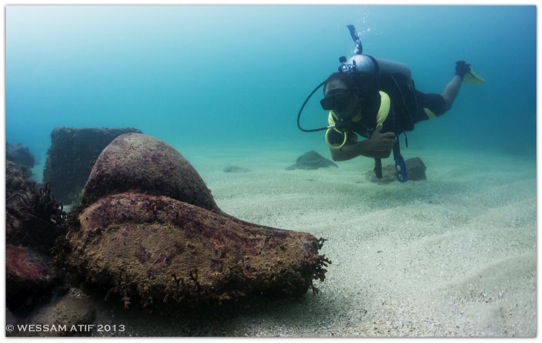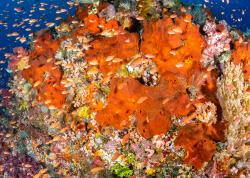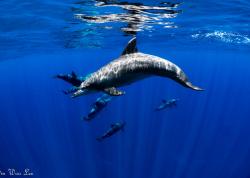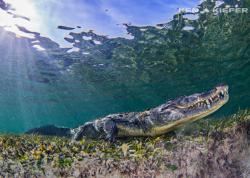Diving into Egyptian History

1400 years ago in Egypt there was a terrible earthquake and a huge tsunami that hit the coast of the great city of Alexandria. It sank the island of Antirhodos, taking down queen Cleopatra’s palace and Alexandria’s old lighthouse, once a wonder of the ancient world.
Today we dive where Antirohodos Island once was, taking you on a journey to see and enjoy what’s left of Cleopatra’s sunken palace under the sea of Alexandria. Or learn more about diving Egypt.
Site History
The city of Alexandria was founded in 332 BC by Alexander the Great, conquering Egypt in a conquest to expand his vast empire. After Alexander’s death, Greek occupation of Alexandria lasted 300 years until the start of Cleopatra’s reign. Queen Cleopatra was a full-blooded Greek and a mighty Egyptian Pharaoh. Her palace was spectacular - a landmark and symbol or her power. She ruled Egypt and spent much time creating alliances with Roman leaders to keep them from occupying Egypt. Tragically, she took her own life when she felt her efforts were about to fail, thinking Roman invasion was imminent.
The earthquake and tsunami that sank the island of Antirhodos occurred a few centuries after Cleopatra’s death, destroying and scattering the palace under about 10 meters of murky water in a small bay. Little was known of Cleopatra’s palace until the 1990s, when French archeologist Franck Goddio stumbled across the ancient writings of a Greek historian named Strabo. Strabo described the great city of Alexandria and the island of Antirhodos, which seemed to be located in a bay near by the city’s shore. In these writings Strabo also described Queen Cleopatra’s palace, built on that same island.

Diver checking an old bowl, most likely used to store food or water in ancient Egyptian times. Canon PowerShot S110, Nauticam housing, Inon wide angle wet lens and dome, ambient light. F3.2, 1/60, ISO 200.

Diver hovering over the remains of the sunken palace of Cleopatra. We can see what seems to be remains of red granite pillars and columns from the ancient times.
F3.2, 1/80, ISO 200.
Rediscovery of the Site
Franck Goddio, who is also the President of the European Institute of Underwater Archaeology, spent 10 years planning an expedition to uncover the secrets of Cleopatra’s sunken palace, determined to find and bring it back to light.
While exploring the sunken island of Antirhodos during the expedition, guided only by Strabo’s ancient descriptions, Goddio's team started to find clues: a wreck of an ancient cargo ship more than 30 meters long, jewelry, hairpins, rings and glass cups.
In the late 1990s, divers discovered the remains of ancient docks at the eastern side of the island as well as a series of giant columns/pillars made of red Egyptian granite with shattered pottery beneath them. There were more than 60 pieces, each 4 feet in diameter and 7 meters in length.
Ancient paintings indicate the columns/pillars acted as a ceremonial gateway to the island. Each column had a decorated crown on top and together they created a magnificent entrance - one fit for a queen.
Inspired and dedicated, Goddio’s team finally found the wooden foundation of Cleopatra’s palace, carbon dating it to approximately 200 years before her birth. Because of this, Goddio believes Cleopatra inherited the palace. The team also discovered statues believed to be part of Cleopatra’s shrine/temple, a statue of her high priest and 2 perfectly preserved sphinxes (spiritual guardians of temples).

The remains of a red granite pillar or perhaps a tower. F3.2, 1/60, ISO 200.

Diving Cleopatra's Palace Today
Unfortunately for divers, all the well-preserved pieces Goddio dug out have been taken out of the water to tour the world museums. These are the images you’ll see when searching for Cleopatra’s palace on the Internet. The team took detailed photos of everything before lifting it, but that’s not quite the same as diving among the historic relics. That said, there are still some artifacts for divers to see today and you can feel the presence of history all around you underwater.
Diving the Mediterranean might take some getting used to if you only dive tropical water. Waves can be big and strong, while visibility is a serious issue that you should never underestimate, especially if you’re planning to take photos. Vis is less than 1 meter in some locations and a maximum of 4 to 5 meters on a good day. Sometimes you may even have to hold the hand of your dive guide during descent. It's well worth it though.
The site is really shallow, just 5 to 8 meters, which gives you plenty of bottom time. You can see many of the columns of the palace, huge stones everywhere, big bowls used in ancient times to keep water or food and two Sphinxes. The Sphinx that appears in the photos of this article had its head separated from its body. You may also see stones with ancient Egyptian writings on it if the visibility is good enough (by good enough I mean more than 2 meters).
In conclusion, diving Cleopatra’s palace is an amazing experience as long as you know what to expect. You will not see the detailed artifacts shown in museum photos, but you will find interesting diving in one of the oldest historical sites underwater. It’s an unforgettable dive experience.



Further Reading
RECOMMENDED ARTICLES
SUPPORT THE UNDERWATER PHOTOGRAPHY GUIDE:
The Best Service & Prices on u/w Photo Gear
 Visit Bluewater Photo & Video for all your underwater photography and video gear. Click, or call the team at (310) 633-5052 for expert advice!
Visit Bluewater Photo & Video for all your underwater photography and video gear. Click, or call the team at (310) 633-5052 for expert advice!
The Best Pricing, Service & Expert Advice to Book your Dive Trips
 Bluewater Travel is your full-service scuba travel agency. Let our expert advisers plan and book your next dive vacation. Run by divers, for divers.
Bluewater Travel is your full-service scuba travel agency. Let our expert advisers plan and book your next dive vacation. Run by divers, for divers.































